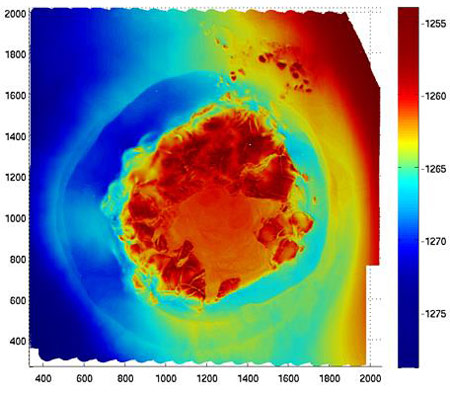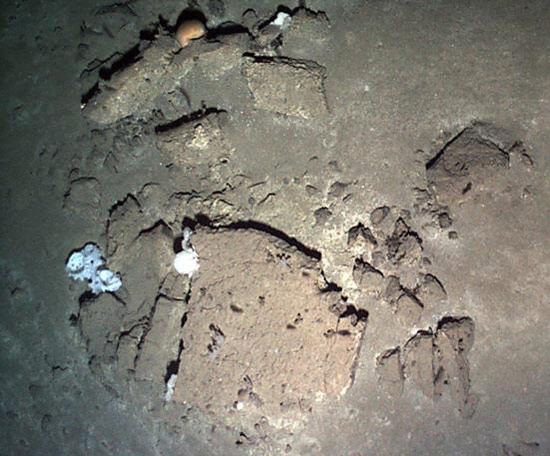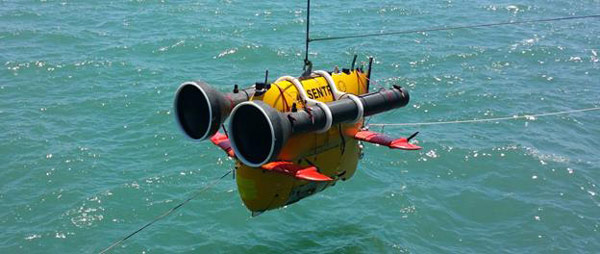
By Dr. Carl L. Kaiser, Woods Hole Oceanographic Institution

Sentry being launched from the Atlantis at sunset. This is Sentry’s normal configuration and how it looks on most dives. Image courtesy of Lance Wills – WHOI. Download larger version (jpg, 54 KB).
Sentry is a 6,000-meter depth rated autonomous underwater vehicle (AUV). AUVs operate without direct human control or connection to the ship and can perform diverse missions, such as sonar surveys, image collection, water chemistry measurements, and magnetic measurements. AUVs are also increasingly used for sample collection.
Sentry is a unique AUV design intended to operate very close to the seafloor on rough terrain. The wings on Sentry actually allow it to “fly” over the ocean bottom—functioning more like an airplane and less like a traditional submarine.
The most common missions for Sentry involve searching for features on the seafloor. The features can be humanmade, like shipwrecks or pollution, or natural features like hydrothermal vents or deep-sea corals. Another common use of Sentry is to make systematic maps of a region to inform long term geological processes.

Bathymetric map of a mud volcano. Bathymetric maps are like topographic maps but show depth below mean sea level instead of height above. Data collected and processed by the AUV Sentry team under the direction of Dr. Christopher German – WHOI. Download larger version (jpg, 159 KB).
The primary system that Sentry uses to map the seafloor is sonar (SOund NAvigation and Ranging). Where sound travels much farther through water than light or radar, it is possible to make large maps much more quickly using sonar. The main mapping sonar on Sentry is called a Multibeam Echo Sounder (MBES). The MBES emits pulses of sound into the water and listens for the echo from the seafloor. However, instead of just listening for one return at a time, the MBES can actually listen to 512 echoes at the same time—all from different portions of the seafloor. From these echoes, the shape of the seafloor can be calculated. By collecting millions of echos over a 25- to 30-hour dive, a detailed 3D model of the seafloor can be generated, with a resolution as fine as 20 inches per pixel.

Sponges on a carbonate mound in the Atlantic at over 2,000 meters depth. Image courtesy of the AUV Sentry on a cruise under the direction of Dr. Cindy Van Dover, Duke University. Download larger version (jpg, 138 KB).
While sonar is very useful over large areas, it is still easier to visually interpret a photographic image. For this reason, Sentry incorporates a high-resolution digital camera. This camera can take a picture every three seconds for up to 60 hours, providing scientists with immense data about what is present on the seafloor.
Since the deep ocean is completely dark, Sentry carries two high-power strobe lights that fire every time the camera takes a picture. These strobes are five-to-ten times more powerful than a good photography studio strobe and so powerful that if you look directly at it, you will be momentarily nearly blind.

Sentry carrying the SyPRID sampler (aka, Plankzooka) in 2015. Image courtesy of Carl Kaiser – WHOI. Download larger version (jpg, 99 KB).
Because of its unique shape and “flight” ability, Sentry is also able to perform unique sample collection work. Perhaps the most unusual of these is the SyPRID (Sentry Precision Robotic Impeller Driven) sampler—or Plankzooka—which filters almost two million liters of seawater per hour to collect larvae from the deep ocean. This capability allows scientists to understand how deep-sea organisms reproduce and spread in a very precise way.
Sentry is not only for science, but also for other national needs. Sentry was deployed extensively during and after the Deepwater Horizon oil spill to help understand the ecological impacts. Recently, it was used to locate the voyage data recorder (black box) from the El Faro shipwreck, which sank in a hurricane in the Fall of 2015, taking 32 lives. This is an excellent demonstration of the ways by which capabilities developed for science and exploration can be reused to support other national priorities.
Sentry is a part of an organization called the National Deep Submergence Facility (NDSF), which is operated by Woods Hole Oceanographic Institution. NDSF is an organization set up jointly by the National Science Foundation, the National Oceanic and Atmospheric Administration, and the Office of Naval Research, to provide researchers access to the deep ocean, as well as to serve other national needs. NDSF includes not only the AUV Sentry, but also the remotely operated vehicle Jason and the manned submersible Alvin .